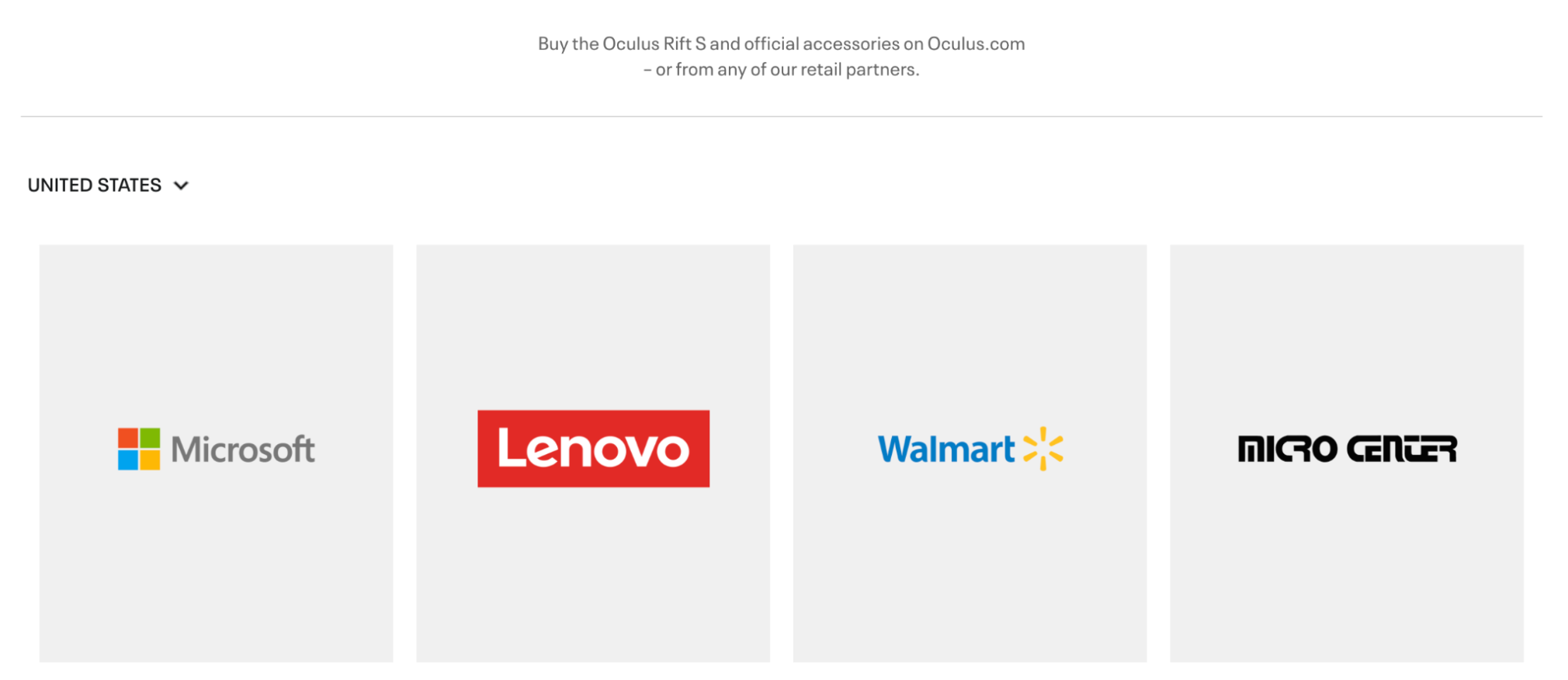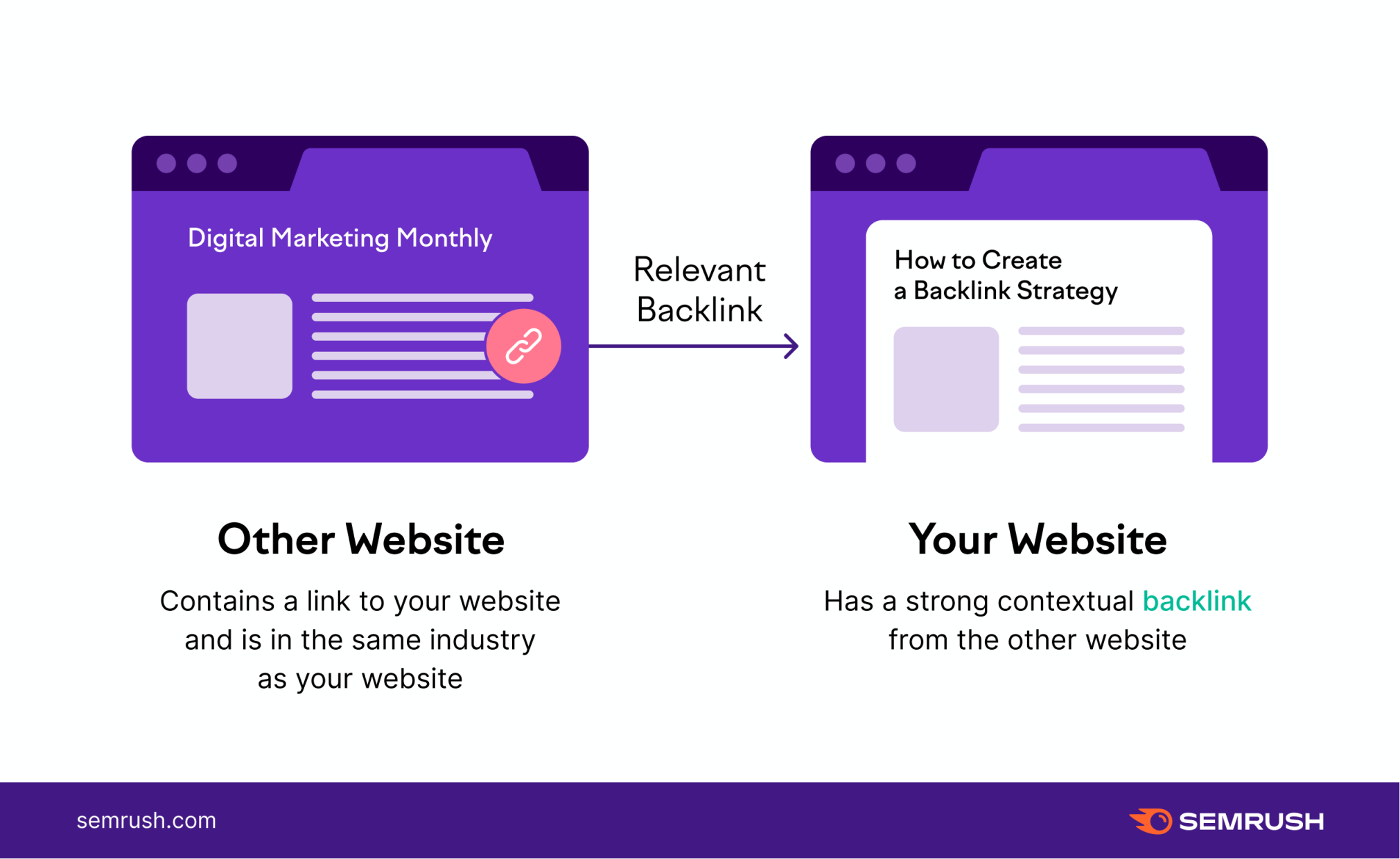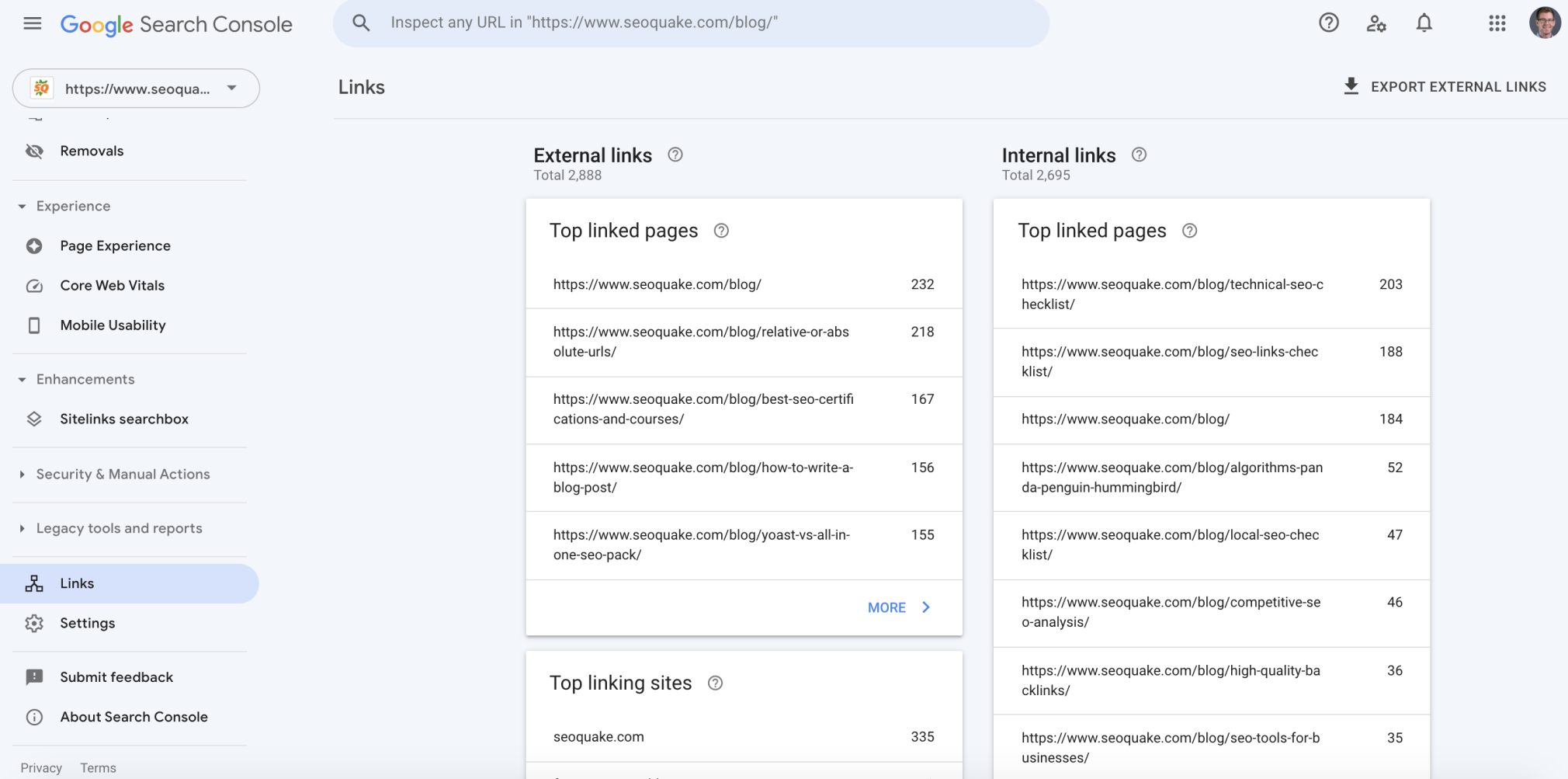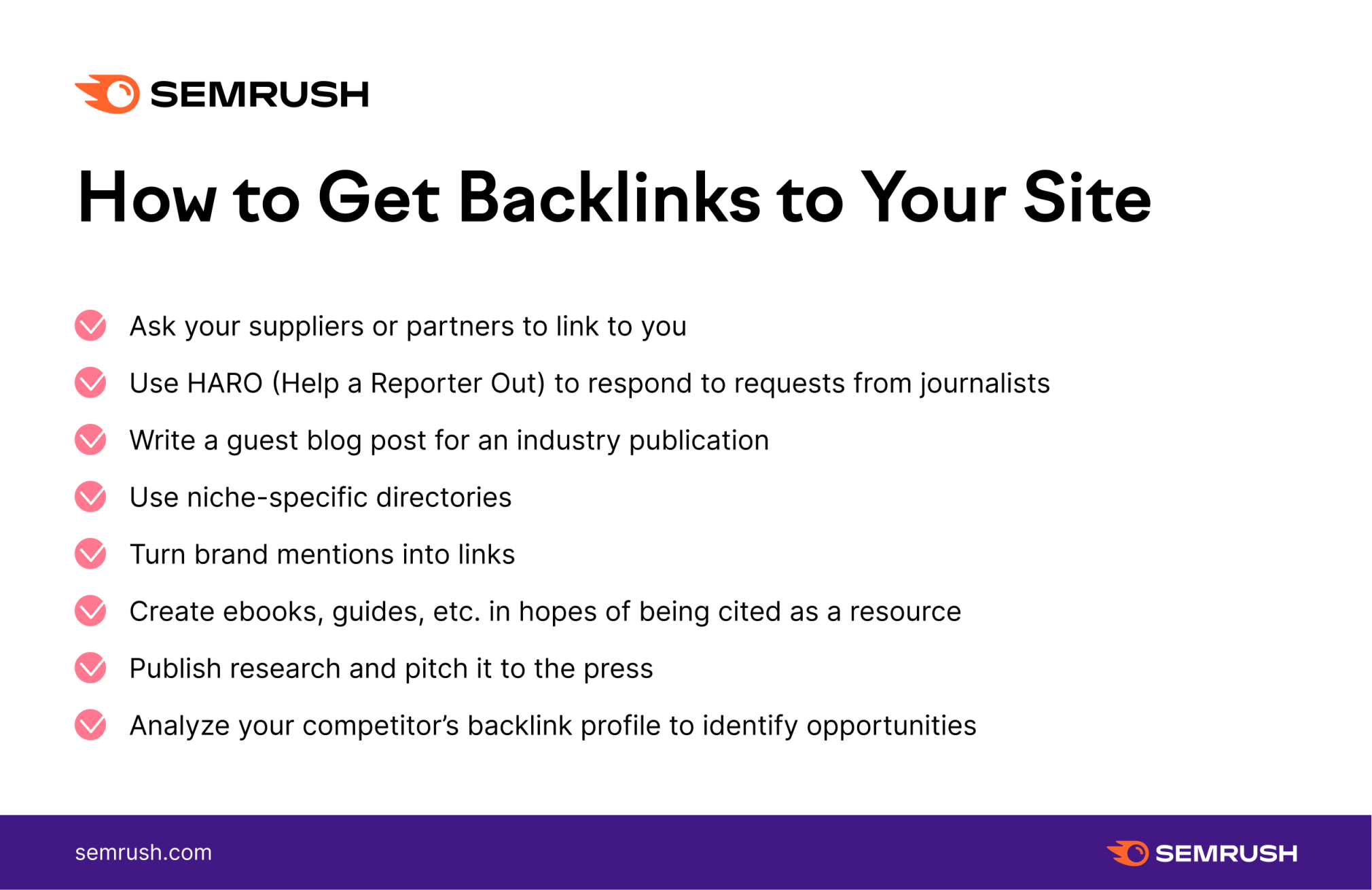What are Backlinks?
Backlinks — also known as inbound links or external links — refer to links on one website pointing to another website.
Search engines, like Google or Bing, view backlinks as indicators of quality content that has the support of other websites. Pages with more backlinks can rank higher on SERPs (search engine results pages).
The Importance of Backlinks in Your SEO Strategy
Do backlinks have an impact on your SEO? Yes! Backlinks are a critical component of SEO. Having authoritative links to your website is one of the most important signals that Google (and other search engines) consider for ranking content.
But what makes a high-quality backlink?
Trust is a huge factor — if a quality website with an excellent reputation links to your site, that’s a fantastic vote of confidence. If you only have sites that Google considers spammy linking to your website, it’s not likely to help you much.
Popularity is another consideration. Because Google views external links as votes of popularity for a website or webpage, there is a strong correlation between sites with lots of (quality) backlinks and higher rankings.
See this link on Wired’s review to the GoPro Hero 8 Black?

This is an example of a backlink. GoPro is receiving a backlink from an article on Wired to a product page on GoPro’s website.
And these ‘shop now’ links to Microsoft, Walmart, and more on Oculus’ “where to buy” page? They’re backlinks, too.

Any link from someone else’s website to yours is a backlink, but, as we’ve mentioned, not all links are created equal.
Just as you would trust a recommendation from someone you respect over someone you have never met before, Google trusts backlinks from trusted, authoritative websites over those that are less trustworthy or unknown.
This trust comes in the form of PageRank, one of Google’s algorithms that evaluates the quality and quantity of backlinks pointing to a page to determine a relative score of that page’s importance and authority.
If your site is receiving backlinks from quality websites relevant to your industry, you’re sending strong signals to Google that your site is viewed as an authority in your industry.
Types of Backlinks
As mentioned, not all backlinks are the same. Let’s learn about the different types of backlinks your site can acquire:
Nofollow Links
We have already shared that links are like votes for trusted resources, but what if you don’t want to vouch for a website but still need to link to it?
Nofollow links use the rel=”nofollow” attribute to inform Google and other search engines that they shouldn’t pass trust (PageRank). A nofollow backlink looks like this:
<a href="https://www.domain.com/" rel="nofollow">this is a nofollow link</a>
Given that nofollow links don’t pass PageRank, they won’t necessarily help you rank higher on the SERPs. However, Google announced in September 2019 that they were evolving the nofollow attribute.
When nofollow was introduced, Google would not count any link marked this way as a signal to use within our search algorithms, but not anymore. All the link attributes are treated as hints about which links to consider or exclude within Search.
Some believe that this change to nofollow links being treated as a hint means that Google will pass trust through nofollow links in some instances, such as when an authority news platform adds the attribute sitewide.
Follow Links
A followed link does pass trust (PageRank) and does not add the nofollow attribute.
Note: there is no ‘follow’ attribute as any link is considered dofollow unless an attribute is added.
A follow backlink looks like this:
<a href="https://www.domain.com/">this is a follow link</a>
Sometimes, you might pay an affiliate or an influencer to promote a piece of your content or to post a review of one of your products.
If money, or a product or service, has changed hands in return for a link, a rel=”sponsored’ attribute should be added to inform Google.
The rel=”sponsored’ attribute stops your site from being negatively impacted by these links. So, if you’re working with an affiliate, you should use the sponsored attribute for this backlink.
A sponsored backlink looks like this:
<a href="https://www.example.com/" rel="sponsored">this is a sponsored link</a>
UGC Links
Another of the new link attributes rolled out in 2019 were UGC (user-generated content) links. UGC links come from the likes of forums and blog comments. The attribute informs Google that the link has been placed by a user and not the webmaster.
A UGC backlink looks like this:
<a href="https://www.example.com/" rel="ugc">this is a UGC link</a>
High Authority Links
Now that we’ve discussed the different types of backlinks let’s find out how to determine the quality of a backlink. Using the Backlink Audit Tool, you can view how many backlinks your site has, the referring domains of those backlinks, the toxicity of those sites, and more.
The overview page gives you a summary of the essential information.

You can dive deeper into the reports in this tool to view your top referring domains and view metrics related to your backlinks, like Authority Score and Toxicity Score.

You can also integrate Google Search Console and Majestic to ensure you don’t miss any backlinks pointing to your site.
The goal is to get backlinks from high-authority sites relevant to your website. Here are some factors that can help you determine if your site is receiving quality backlinks:
- A high number of referring domains
- Its placement on the page (the higher up on the page, the better)
- If they are contextual backlinks (links surrounded by related content on the page)
- If it contains relevant anchor text
As mentioned previously, Google assesses authority through their PageRank algorithm, but that’s no longer a public-facing metric since they stopped updating and subsequently retired their PageRank Toolbar in 2016.
When assessing whether a link is high quality or not, consider factors such as credibility and whether the site shares quality content of real value to users.
Build quality backlinks to your site
with our Link Building Tool

Toxic Links (Unnatural Links)
The wrong links can harm your website’s ability to rank or negatively impact any rankings you already have. “Bad” links are often referred to as toxic or unnatural links.
Toxic backlinks, which usually come from low-quality or suspicious websites, directly violate Google’s Webmaster Guidelines and exist solely to try and manipulate search engine rankings.
This could mean paid links that aren’t marked with nofollow or sponsored attributes, those from low-quality directories or bookmark sites, or an unnatural number of links that use exact match anchor text.
You can also use the Backlink Audit Tool to review your backlinks and identify potential toxic or unnatural links.

Once the analysis is complete, you can choose from several actions, including generating a disavow list and submitting it to the Google Disavow Tool.
Leave links in your “remove” list if you want to contact a site manually to request removal or approve any links you know are safe.

You can do this directly through the Backlink Audit tool if you need to clean up toxic links and request removal.
Editorially Placed Links
Google rewards and passes the most significant authority through editorially placed links. An editorially placed or earned link is a link a journalist or webmaster has decided to add that links to your webpage.
It is a link to another website or webpage due to it being deserved of being sent traffic and authority. The reason for the link is to enhance a reader’s experience, not to manipulate search engine algorithms.
Why are Backlinks Important?
When it comes to search engine optimization, backlinks are talked about a lot and are the focus of site owners everywhere. But why are backlinks important? We’ll dive into a few of the reasons why you should care about incoming links to your site.
Backlinks Can Improve Rankings
Without great backlinks pointing to your site, you miss out on one factor that goes into understanding a website — trustworthiness. Backlinks showcase that you are a trusted authority in your industry and deserve to rank at the top for key search terms.
Google Finds New Pages via Backlinks
Google’s spiders (Googlebot) uses links to find new pages on the web — this is one of the main ways content is discovered, crawled, and indexed.
One way to think of links is how Google navigates the web. A link from a trusted source will help your content indexed faster by Google.
Backlinks Boost Your Trustworthiness & Credibility
Quality links from authoritative and trusted sources help you to rank higher from an SEO perspective, but they can also help boost your trustworthiness and credibility as a business. Think about it this way: let’s say you are a tech startup. There is a good chance not too many people know about your business (yet).
If you manage to land some press coverage and a link from TechCrunch, you will get a credibility boost from that. If you then go on to gain links from the BBC, TechRadar, and Wired, those are some serious industry authority (and relevant contextual links) for your website.

Besides being good for your site’s SEO, having journalists and editors at key publications in your industry who choose to link to you goes a long way to show people are talking about your business.
Backlinks Send Referral Traffic to Your Page
When the web first launched, links were solely navigational. In the most simplistic form, the purpose of links is to take web browsers from Page A to Page B, not just within one website but also between different sites.
While links are now used within Google’s algorithm, the principle hasn’t changed: excellent links send valuable traffic to your page.
If we step back to the example above, relevant press coverage can send interested readers to your site — introducing your brand to new audiences who could turn into customers.
Pro Tip: You also can add this traffic to a remarketing list to target across paid media channels to make your referral traffic work that little harder.
How to Check Any Website’s Backlinks
Checking sites for backlinks is helpful whether you’re planning a link building campaign or benchmarking your site against competitors’ sites.
You can get insights about your site’s backlink profile from tools like Google Search Console, but you’ll need more detailed information about other websites’ backlink profiles — and you can do so using Semrush.
Using Google Search Console to Understand Your Link Profile
Google Search Console will give you an insight into what your link profile looks like, but it won’t provide any information about your competitors.
To start, head over to Google Search Console and log in. Using the left-hand menu, navigate toward the bottom of the menu and you’ll find Links.

You should then see an overview of your website’s backlink profile under the “External links” heading.
You will be able to see insights into:
-
External links – How many external links point to your site.
-
Top linked pages – The pages on your site with the most backlinks pointing to them.
-
Top linking sites – The website which links to yours the most times.
-
Top linking text – The most common link anchor text used for external links.
You can also export your site’s external links as a CSV file in the top right corner.
Using Semrush to Analyze Backlinks
Start by using our Backlink Analytics Tool to gain insights into a whole host of metrics and data points to help you develop a better strategy. Once you have loaded up a domain into the tool, you are ready to start gaining a deeper insight into the site’s link profile.
Unlike GSC, Semrush allows you to get insights on your competitors’ backlink profiles, helping you build your link building strategy by analyzing what your competitors are doing.
The primary metrics Backlinks Analytics provides are:
- Authority Score
- Referring domains
- Backlinks
- Monthly visits
- Keywords
- Overall toxicity score
You can click each number for a more detailed corresponding report.

The Overview tab will show highlights from up to five websites at a time. Click through any widget to access the more detailed report.

You can also export data to a PDF, whether you need to analyze yourself or send competitor research to a client.

Using Backlink Analytics, you’re able to find the following information about a site’s backlinks:
- Overall number of backlinks
- Pages with the most backlinks
- TLD (top-level domain) distribution
- The categories of their referring domains
- Referring domains by Authority Score
- Top anchor text for backlinks
- Link attributes (i.e., follow, nofollow, sponsored, or UGC)
- Similar profiles (domains with similar link profiles that could be useful for link building opportunities)
Whether you’d like to analyze your backlinks or see how your competitors are doing, this tool is a great place to start.
How to Get Backlinks to Your Site
How do you go about building backlinks? You can read our full guide to link building for a full overview of how to do it, but here are a few key link building strategies that we’ve broken down for you:

From the skyscraper technique to building a strong digital PR campaign to looking at your competitors’ backlink portfolio, there are many ways to maximize your link building efforts.
Pro Tip: A quick way to analyze potential ways to build links is to look at your competitors’ backlinks. You can see how your competitors are doing with the Backlink Gap Tool.
Enter your domain alongside your main competitors to get started:

It is an excellent way for you to identify gaps in your competitors’ link building strategies and prioritize opportunities where you have established that one or more competitors have earned links from a domain that you haven’t.

Debunking Common Backlink Myths
Link building has changed significantly over the last decade. Here are some common myths to take note of before beginning your link building strategy:
- The more links you have, the higher you will rank — Not all links are equal, so many links from a spammy site wouldn’t carry the same weight as a link from a top industry publication.
- You shouldn’t bother earning nofollow links — Historically, nofollow links haven’t impacted SEO performance. However, many SEOs believe that Google may choose to follow nofollow links at times (for example, when top-tier newspapers automatically apply the nofollow attribute to all of their sites). Even so, links that are relevant and from trusted sources are still helpful!
- Buying links is a quick way to boost your rankings — Buying links (or gifting free products in exchange for links) is a direct violation of Google’s webmaster guidelines, so you’ll want to avoid this and avoid any penalties. If you are sponsoring content for other reasons besides getting a link, you need to be using the rel=”sponsored” attribute.
- You receive a penalty if you earn too many links — As always, quality over quantity! Avoid shady link-buying practices and monitor your backlink profile. But there is no penalty to having “too many good backlinks.”
Get Started Creating a Link Building Strategy
Backlinks are a key aspect of Google’s algorithm when ranking content. You’ll need to earn backlinks from relevant and authoritative sites to build your website’s profile.
Now that you know more about backlinks, you’re ready to start working on building an excellent backlink portfolio for your site. Be sure to keep an eye out for what your competitors are doing and jump onto fresh opportunities as quickly as possible.
Build quality backlinks to your site
with our Link Building Tool


